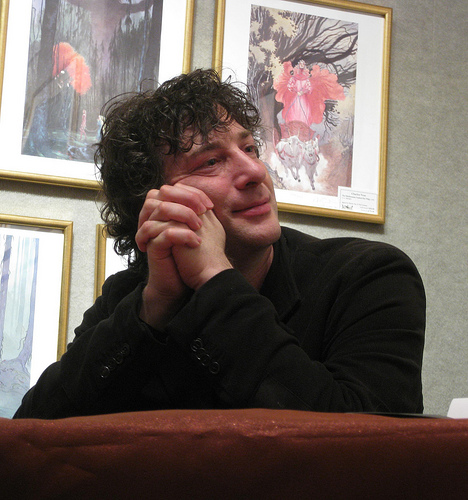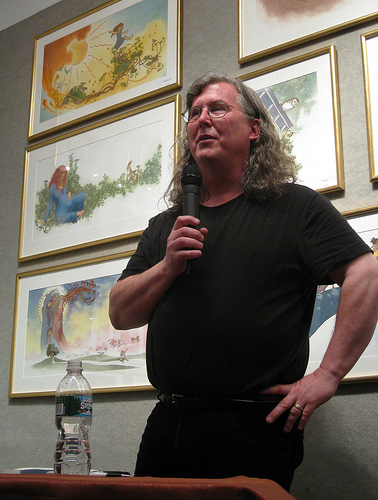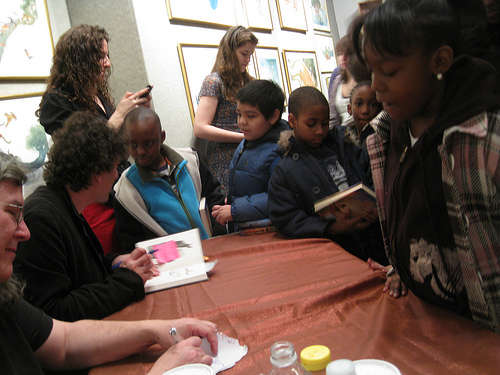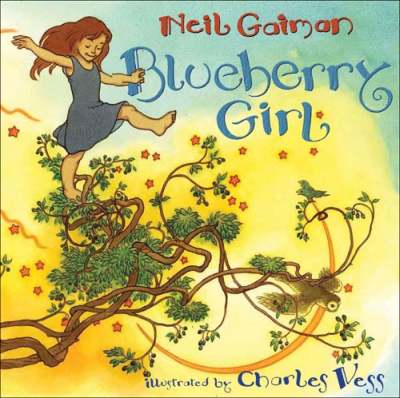According to Neil Gaiman, our story begins in a “very cheap” hotel in Las Vegas, where the author had checked in for two weeks in order to finish his current novel, American Gods. While there, he received a call from his friend and muse, singer-songwriter Tori Amos, announcing the due date for her baby girl. She then asked Gaiman to write something in the spirit of a blessing or a prayer for the occasion, “something small and magical for her daughter-to-be.” So he thought for a bit and wrote up a brief but rather wonderful poem expressing his sweet, simple, deeply-felt wishes for the child at the start of her new life. It was, as Gaiman points out, probably very different from the kind of prayer usually uttered in Las Vegas.
For several years, the poem remained relatively private; Gaiman would read it occasionally (but asked people not to record it), and gave away copies on request, until he and artist Charles Vess began trading ideas at the Fiddler’s Green Sandman Convention in 2004, and decided to turn it into a book. Five years later, their labor of love has come to fruition in the form of the inspired Blueberry Girl, released on Saturday from HarperCollins Children’s Books.
 The official release of the book was accompanied by an art show, reading, and signing by both Gaiman and Vess at the fabulous Books of Wonder children’s bookstore here in New York. While there were plenty of children on hand, the massive crowd that began lining up hours ahead of the signing represented a broad spectrum of fans, friends, and well-wishers, from teenage goth chicks wearing Death-inspired swirls of eyeliner to Absolute Sandman-toting fanboys (arguing over the Watchmen movie in line, of course), to a host of editors, writers, and especially artists (including Gaiman collaborators Michael Kaluta and Rick Berry). By the time everyone had finally squeezed in for the reading, little kids and black-clad industry hipsters sat squished together, Indian-style, on the floor, all staring eagerly up at Vess and Gaiman like rapt preschoolers ready for storytime, and no one was disappointed.
The official release of the book was accompanied by an art show, reading, and signing by both Gaiman and Vess at the fabulous Books of Wonder children’s bookstore here in New York. While there were plenty of children on hand, the massive crowd that began lining up hours ahead of the signing represented a broad spectrum of fans, friends, and well-wishers, from teenage goth chicks wearing Death-inspired swirls of eyeliner to Absolute Sandman-toting fanboys (arguing over the Watchmen movie in line, of course), to a host of editors, writers, and especially artists (including Gaiman collaborators Michael Kaluta and Rick Berry). By the time everyone had finally squeezed in for the reading, little kids and black-clad industry hipsters sat squished together, Indian-style, on the floor, all staring eagerly up at Vess and Gaiman like rapt preschoolers ready for storytime, and no one was disappointed.
 Blueberry Girl is a luminous evocation of the joyfulness and unlimited potential of childhood. The warmth and exuberant energy of Vess’s illustrations perfectly complement Gaiman’s thoughtful, touching benediction, bringing a sense of playfulness to the wise, sometimes wistful tone of the poetry. After the reading, Charles Vess gave a brief run-through of his work on the project, including a slideshow of initial rough sketches, drawings, and different versions of the final paintings. He also explained that he didn’t want to tie the idea of the Blueberry Girl to a single, specific character—instead, she changes throughout the book, inhabiting different sizes, shapes, races, and ages in a way that makes the spirit of the poem accessible and applicable to any child, yet tied together through a series of repeated visual elements. The final product is simply lovely, and sure to become a much-loved classic in the world of children’s literature.
Blueberry Girl is a luminous evocation of the joyfulness and unlimited potential of childhood. The warmth and exuberant energy of Vess’s illustrations perfectly complement Gaiman’s thoughtful, touching benediction, bringing a sense of playfulness to the wise, sometimes wistful tone of the poetry. After the reading, Charles Vess gave a brief run-through of his work on the project, including a slideshow of initial rough sketches, drawings, and different versions of the final paintings. He also explained that he didn’t want to tie the idea of the Blueberry Girl to a single, specific character—instead, she changes throughout the book, inhabiting different sizes, shapes, races, and ages in a way that makes the spirit of the poem accessible and applicable to any child, yet tied together through a series of repeated visual elements. The final product is simply lovely, and sure to become a much-loved classic in the world of children’s literature.
 Finally, I have to note that both Neil Gaiman and Charles Vess deserve praise not only for this remarkable achievement but for their generous and incredibly gracious decision to remain at the signing until every person who lined up was able to have his or her books autographed. In the end, they signed, chatted amicably, and posed for pictures for over eight hours. This sense of mutual appreciation and dedication between the author and artist and their public is nothing short of inspiring, and I think I speak for everyone who was there—goth kids, preschoolers, fanboys and hipsters alike—when I say that it was both an honor and a pleasure to be a part of it.
Finally, I have to note that both Neil Gaiman and Charles Vess deserve praise not only for this remarkable achievement but for their generous and incredibly gracious decision to remain at the signing until every person who lined up was able to have his or her books autographed. In the end, they signed, chatted amicably, and posed for pictures for over eight hours. This sense of mutual appreciation and dedication between the author and artist and their public is nothing short of inspiring, and I think I speak for everyone who was there—goth kids, preschoolers, fanboys and hipsters alike—when I say that it was both an honor and a pleasure to be a part of it.










